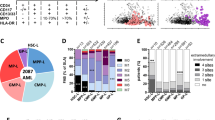Abstract
The effect of 3 anthracene derivatives, mitoxantrone, ametantrone, bisantrene, on 4 normal human bone marrows, was studied using the myeloid stem cell assay developed by Pike and Robinson, in order to define to what extent this test could be used to predict the relative clinical hematologic toxicity of new anticancer agents. For the 3 drugs, an exponential relationship between colony survival and drug concentration was found, but was much steeper for mitoxantrone (slope = -195.2 ± 8.8/μg/ml) than for ametantrone (slope = 5.1 ± 1.0/μg/ml, p⩽0.001) and bisantrene (slope = 7.1 ± 0.3/μg/ml, p⩽0.001). The difference of slope between ametantrone and bisantrene was of borderline significance (p⩽0.05). The ratios of concentrations inducing a 50% growth inhibition for mitoxantrone versus bisantrene and for ametantrone versus bisantrene were close to the corresponding ratios of concentrations inducing a 90% growth inhibition. The relative in vitro toxicities reproduce very well the relative myelosuppression observed in clinical trials with mitoxantrone versus bisantrene but the results were less satisfactory for the comparison of these 2 agents with ametantrone. In addition, our data suggest that, for these 3 compounds, intrinsic myeloid progenitor sensitivity is a major determinant of leukopenia.
Similar content being viewed by others
References
Pike BL, Robinson WA: Human bone marrow colony growth in agar gel. J Cell Phys 76:77–84, 1970
Spiro TE, Mattelaer MA, Efira A, Stryckmans P: Sensitivity of myeloid progenitor cells in healthy subjects and patients with chronic myeloid leukemia to chemotherapeutic agents. J Natl Cancer Inst 66:1053–1059, 1981
Piccart M, Rozencweig M, Abele R, Cumps E, Dodion P, Dupondt D, Kisner D, Kenis Y: Phase I clinical trial with ametantrone (NSC-287513). Eur J Cancer 17:775–779, 1981
Loesh DM, Von Hoff DD, Kuhn J, Coltman CA, Tio F, Chaudhuri TK, Bender JF, Grillo-Lopez AJ: Phase I investigation of ametantrone. Cancer Treat Rep 67:987–991, 1983
Von Hoff DD, Pollard E, Kuhn J, Murray E, Coltman CA Jr: Phase I clinical investigation of 1,4-dihydroxy-5,8-bis (2-(2-hydroxyethyl) amino ethyl)amino))-9,10-anthracenedione dihydrochloride (NSC-301739), a new anthracenedione. Cancer Res 40:1516–1518, 1980
Von Hoff DD, Myers JW, Kuhn J, Sanbach JF, Pocelinko R, Clark G, Coltman CA: Phase I clinical investigation of 9,10 anthracenedicarboxaldehyde bis (4,5 dihydro-1H imidazol-2-yl) hydrazone dihydrochloride (Cl 216, 942). Cancer Res 41:3118–3121, 1981
Crossley RJ: Clinical safety of mitoxantrone (novantrone). Cancer Treat Rev 10 (supp.):29–36, 1983
Spiegel R, Blum R, Pinto C, Wernz J, Levin M, Hoffman K, Blank J, Muggia FM: Phase I trial of 9,10-anthracenedionedicarboxaldehyde (CL 216,942). Proc Am Assoc Cancer Res and Proc Am Soc Clin Oncol 22:357, 1981
Yap HY, Blumenschein GR, Schell FC, Buzdar AU, Valdivieso M, Bodey GP: Dihydroxyanthracenedione: a promising new drug in the treatment of metastatic breast cancer. Ann Intern Med 95:694–697, 1981
Stuart-Harris R, Mooney C, Smith IE: Mitoxantrone, an active and well tolerated agent in the treatment of advanced breast cancer: a phase II study. Cancer Chemother Pharmacol 9:52, 1982
Yap H-Y, Yap B-S, Blumenschein GR, Barnes BC, Schell FC, Bodey GP: Bisantrene, an active drug in the treatment of metastatic breast cancer. Cancer Res 43:1402–1404, 1983
Paciucci PA, Ohnuma T, Cuttner J, Silver RT, Holland JF: Mitoxantrone in patients with acute leukemia in relapse. Cancer Res 43:3919–3922, 1983
Kuhn JG, Ludden TM, Myers JW, Von Hoff DD: Characterization of the pharmacokinetics of bisantrene (NSC-337766). Invest N Drugs 1:253–258, 1983
Powis G, Kovach JS: Disposition of bisantrene in humans and rabbits: evidence for intravascular deposition of drug as cause of phlebitis. Cancer Res 43:925–929, 1983
Lu K, Savaraj N, and Loo TL: Pharmacokinetic studies of mitoxantrone. In: Rozencweig M, Von Hoff DD, Staquet MJ (eds): New anticancer drugs: mitoxantrone and bisantrene. Raven Press, New York, 1983, pp 71–84
Burgess AW, Wilson EC, Metcalf D: Stimulation by human placental conditioned medium of hemopoietic colony formation by human marrow cells. Blood 49:573–583, 1977
Knott GD: MLAB: a mathematical modeling tool. Comp Program Biomed 10:271–280, 1979
Ash RC, Detrich RA, Zanjani ED: Studies on human pluripotential hemopoietic stem cells (CFU-GEMM) in vitro. Blood 58:309–316, 1981
Bowden GT, Garcia D, Peng Y-M, Alberts DS: Molecular pharmacology of the anthracycline drug 9, 10-anthracenedicarboxaldehyde Bis((4,5-dihydro-1 H-imidazol-2-yl)hy-drazone) dihydrochloride (C1 216,942). Cancer Res 42:2660–2665, 1982
Drewinko B, Yang L-Y, Barlogie B, Trujillo JM: Comparative cytotoxicity of bisantrene, mitoxantrone, dihydroxyanthracenedione, dihydroxyanthracenedione diacetate, and doxorubicin on human cells in vitro. Cancer Res 43:2648–2653, 1983
Johnson RK, Broome MG, Howard WS, Evans SF, Pritchard DF: Experimental therapeutic and biochemical studies of anthracenedione derivatives. In: Rozencweig M, Von Hoff DD, Staquet MJ (eds): New anticancer drugs: mitoxantrone and bisantrene. Raven Press, New York, 1983, pp 1–28
Salmon SE, Hamburger AW, Soehnlen B, Durie BGM, Alberts DS, Moon TE: Quantitation of differential sensitivity of human-tumor stem cells to anticancer drugs. N Engl J Med 298:1322–1327, 1978
Selby P, Buick RN, Tannock I: A critical appraisal of the human tumor stem cell assay. N Engl J Med 308:129–134, 1983
Cowan JO, Clark G, Von Hoff DD: Activity of mitoxantrone and bisantrene in a human tumor cloning system. In: Rozencweig M, Von Hoff DD, Staquet MJ (eds): New anticancer drugs: mitoxantrone and bisantrene. Raven Press, New York, 1983, p 39–46
Author information
Authors and Affiliations
Rights and permissions
About this article
Cite this article
Bron, D., Dodion, P., Rozencweig, M. et al. Quantitation of differential sensitivity of normal marrow myeloid progenitor cells to anthracene derivatives. Invest New Drugs 4, 11–16 (1986). https://doi.org/10.1007/BF00172010
Issue Date:
DOI: https://doi.org/10.1007/BF00172010




